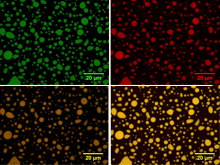The International Symposium on Membrane-Less Organelles in Cell Life and Disease focuses on the characterization of membrane-less organelles in cells, as well as their involvement in normal cell metabolism and the development of diseases.
The Symposium will be held on March 7 and 8, 2023, sponsored by the Ramón Areces Foundation, at the facilities of the Isla de la Cartuja Scientific Research Center (cicCartuja), a joint center of the University of Seville, the Spanish National Research Council (CSIC) and the Junta de Andalucía, and will be coordinated by the University of Seville professors Miguel Ángel de la Rosa Acosta and Irene Díaz-Moreno.
How do cells exercise spatiotemporal control of complex biochemical reactions within themselves?
How do cells exercise spatiotemporal control of complex biochemical reactions within themselves? The answer to this question lies, in part, in the creation of compartments or organelles that allow the coexistence of different chemical environments. Most of these compartments are isolated by surrounding membranes (nucleus, mitochondria, chloroplasts, lysosomes, etc.) and it is easy to understand how they coexist and function in the same cell. Many others, however, lack membranes (nucleoli, centrosomes, Cajal bodies, stress granules, etc.), making it difficult to explain their coexistence. The latter, known as MLOs (from English, Membrane-less Organelles) remain independent within the cell by avoiding the mixing of their components with the environment. The following questions immediately arise: Are there molecules that are transported in and out of the MLOs? How fast must the diffusion of the components within the MLOs be to ensure that the chemical reactions are efficient?
Recent evidence has shown that many MLOs are liquid and are formed by liquid-liquid phase transitions, allowing components of MLOs to rapidly concentrate at a particular location in the cell. Liquid droplet assembly is regulated by i) weak multivalent interactions between repeating signaling domains in proteins and RNA, and ii) conformational heterogeneities of intrinsically disordered regions. Under pathological conditions, and especially during diseases that entail major aggregation events, the liquid-liquid transition can eventually evolve into metastable condensates of intracellular matter, such as glass/hydrogels or amyloid-like fibers, that exhibit a liquid-solid phase change.
In conclusion, liquid-liquid phase separation provides a simple yet elegant mechanism for the cell to control the spatial localization and processing of molecules, without relying on the boundaries that a membrane offers.
The combination of approaches in cell biology with quantitative biophysical and structural tools is necessary to elucidate how non-equilibrium conditions present in living cells control intracellular phase transitions. In this Symposium, the confluence of physicists and cellular and molecular biologists will allow us to delve deeper into the formation of MLOs through liquid-liquid phase transitions and the formation of droplets inside the cell. The Symposium will bring together a host of pioneering scientists in a cutting-edge and interdisciplinary topic focused on MLOs and their impact on diseases. Due to its relevance and timeliness, the Symposium will also feature a round table with editors of the three journals that mark international scientific policy (the Big3, Cell, Nature and Science).



